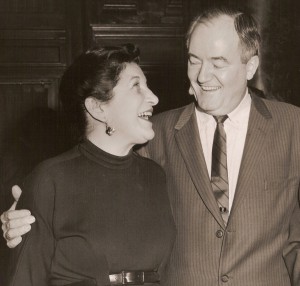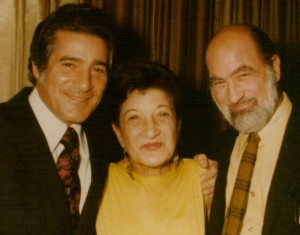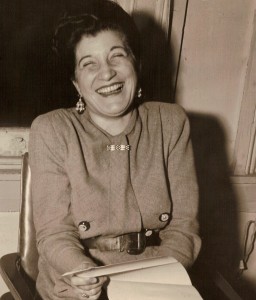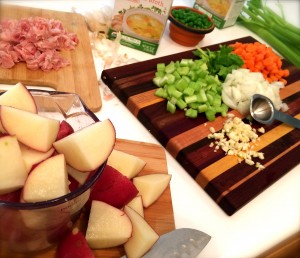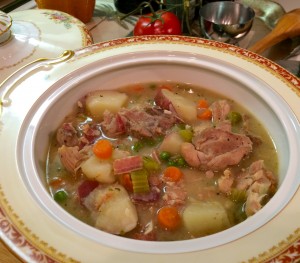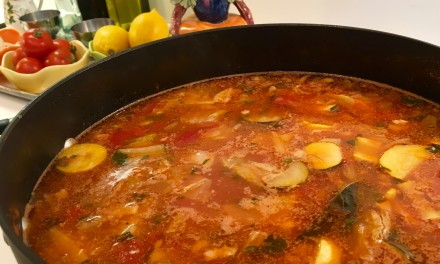Angela’s Chicken Stew and The Story of Angela
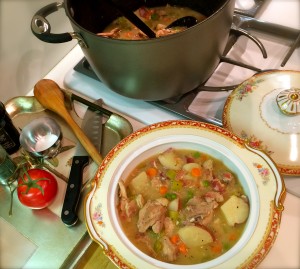 Almost every Sunday, we’d go to my grandmother’s house and have a big Italian dinner. The usual suspects would be there; my Mom and Dad and us three kids, and my uncle Oscar, his wife and three kids. The kids would play in the backyard, wrestle on the living-room floor, and jump on the beds in the basement. Angela would cook, and when the pasta was ready, she’d serve us kids at the kitchen table and say…
Almost every Sunday, we’d go to my grandmother’s house and have a big Italian dinner. The usual suspects would be there; my Mom and Dad and us three kids, and my uncle Oscar, his wife and three kids. The kids would play in the backyard, wrestle on the living-room floor, and jump on the beds in the basement. Angela would cook, and when the pasta was ready, she’d serve us kids at the kitchen table and say…
“Eat that spaghetti or I’ll shove it down your throat.”
Which we kids thought was ridiculously hilarious.
Angela was my grandmother. She was an Italian immigrant, who came from Italy to New York City as a child. The family lived in Harlem. As a teenager, Angela and her sister, Marie, started working in a garment sweatshop — like so many other Italian immigrant women–seven days a week, all day long, for next to nothing. Disgusted with the working conditions, she and Marie helped organize the first dressmakers strike for the fledgling International Ladies Garment Workers Union.
Their mother, Giuseppina, accompanied her daughters on the strike, brandishing a rolling pin, telling anybody within earshot that if anybody messed with her girls, they’d have to go through her first. Angela and Marie continued to organize, with Giuseppina following them with her rolling pin.
Angela was very effective; she was an eloquent, persuasive and fearless organizer. She was eventually offered a chance to organize and manage the Delaware, Maryland, and Virginia area (later known as the Upper South Department of the ILGWU) and she accepted the challenge. So she gathered up her two sons, and moved to Baltimore, Maryland.
Angela started by going to small towns on the Eastern Shore of Maryland. She didn’t drive. The ILGWU eventually found her a driver, a one-eyed African-American named Jesse. I can only imagine what it must have been like, going to these tiny towns in the not-so-deep south, an Italian woman and her black driver, trying to convince people to join the union.
Organizing was a tough business in those days. Factory owners didn’t want anything to do with unions — it would obviously cost them money to pay a decent wage and provide benefits. A lot of those factory owners ran their towns. They had the politicians and police in their pockets.
My grandmother was thrown down a flight of steps when she tried to organize one shop. She was thrown in jail after trying to organize another. She was beaten more than once.
But she persisted. Why? Because it pissed her off the way the workers were treated. Women were locked in factories for hours at a time. One hundred and forty six garment workers died in a fire at the Triangle Shirtwaist factory in New York because the owners had locked the doors to keep the workers inside working. Women were sexually abused. They made very little money. They had no rights. Angela wanted to change all that.
And she did. She took her region of the Ladies Garment Workers Union from nothing to about 16,000 members when she retired in 1972. She was the first woman vice president of a major union. She substantially raised the standard of living for thousands and thousands of people. And she did it without expecting anything in return. She told me more than once…
“When you give, you give with no strings attached.”
Everybody loved her, including the bosses she fought with. They respected her.
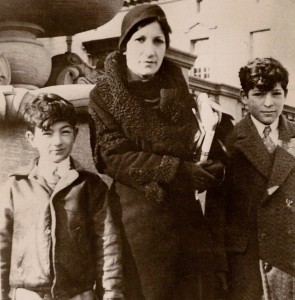 Angela made some tough choices when she started organizing in New York. Her marriage suffered. Her husband, Romollo, was an Italian from Rome; Angela’s father had arranged the marriage. Romollo, who was old-fashioned and older than Angela, didn’t approve of her radicalism, and they filed for divorce. During the divorce, her children — my father Philip and my uncle Oscar – were put in an orphanage while Angela and Romollo, fought for custody.
Angela made some tough choices when she started organizing in New York. Her marriage suffered. Her husband, Romollo, was an Italian from Rome; Angela’s father had arranged the marriage. Romollo, who was old-fashioned and older than Angela, didn’t approve of her radicalism, and they filed for divorce. During the divorce, her children — my father Philip and my uncle Oscar – were put in an orphanage while Angela and Romollo, fought for custody.
Romollo was a waiter at a fancy hotel. Angela was a radical union organizer who’d been thrown in jail. Romollo used that evidence against Angela and won custody; a crushing blow to Angela. She started using her maiden name, Bambace.
Angela stayed close to her kids; she moved to a house in Queens near Romollo’s. She watched over her two boys; she was determined to do whatever she could to help. When she moved the family to Baltimore, she put Oscar through medical school and Philip through law school.
Angela was amazing –feisty, strong, and strong-willed. She drank (bourbon Manhattans or chianti), she smoked (Larks), and she cared more about people than anyone I have ever known.
Angela used to wait in the alley in her housecoat during Christmas to tip the garbage men. Homeless guys would come to the back door; she’d make them a sandwich, and then pay them to do yard work. All this from a woman who was invited to John F. Kennedy’s inauguration and had U.S. Senators sending her Christmas cards. Mayors and governors would stop by the house during holidays.
One day she was in the hospital for a surgery when Hubert Humphrey, the Vice President of the United States called. They were friends. The nurse handed the phone to Angela, but she thought it was her son, Philip, playing a joke. So she hung up, saying she wasn’t in the mood for any of his “crap.”
A few moments later the phone rang again. The nurse told Angela it was the Vice President. Again. She took the call.
Angela would cuss on occasion. I remember one night she took us kids to a restaurant, and she told the Baltimore City Comptroller, Hyman Pressman, that he was “full of shit” after he recited an impromptu poem about my sister. Everyone laughed, including Hyman, who knew my grandmother well, and loved her.
The politicians admired Angela because she was honest, uncompromising; she couldn’t be bought or influenced. She fought for what she believed in. She was a champion to the workers she represented; people who were really struggling to make ends meet.
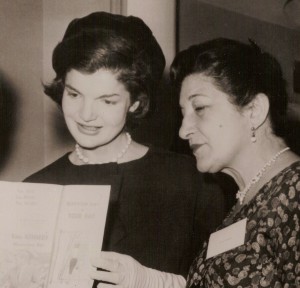 Angela was modest, in every sense of the word. She never bragged about her accomplishments. She lived in a modest house. She didn’t wear diamonds or fancy jewelry. Oscar once bought her a fur coat; she didn’t feel comfortable wearing it, because she thought it would be hypocritical to be fighting for the causes of working people while waltzing around in a mink coat.
Angela was modest, in every sense of the word. She never bragged about her accomplishments. She lived in a modest house. She didn’t wear diamonds or fancy jewelry. Oscar once bought her a fur coat; she didn’t feel comfortable wearing it, because she thought it would be hypocritical to be fighting for the causes of working people while waltzing around in a mink coat.
My family lived with Angela from the time I was born until I was six. I lived with Angela again when I was in my late teens. I used to do her shopping. I’d drive (in the used American Motors Rambler she bought me) to a little store behind the Lexington Market in downtown Baltimore called DiMarco’s. They used to sell Italian meats, cheeses and wines.
I used to buy her Chianti – in the small straw bottles — that didn’t cost more than two or three dollars. Angela and I would have dinner, we’d have a glass of Chianti, and she’d tell me stories about her life. I was fascinated. Crazy how some kids get so attached to their grandparents. I was really attached to Angela.
One night Oscar, her first son, walked in with a suitcase and a case of wine. He told us he had just left his wife. I guess Oscar’s wife wasn’t too happy about it, because the reason he brought the case of wine was because he didn’t want her pouring his ridiculously expensive vino down the sink after he left.
Oscar moved in. The two of us shared my bedroom in Angela’s basement.
Angela and I were having dinner one night when Oscar told us he was going out. He left, and we finished our dinner and our glass of Chianti. When she asked me for another glass, I told her there was no more.
She asked about Oscar’s wine. I told Angela that all we had was Oscar’s special wine. She looked at me and said.
“Who more special than we?”
Angela told me to go get a bottle. So I pulled a bottle from Oscar’s case, and poured us each a glass. Angela took a sip and started laughing. The wine was that incredible.
After we finished our glass of wine, she wanted to go to sleep. I asked her what to do with the wine. She said to stick a cork in it and put it in the fridge, just like we did with the Chianti. I did, and then went to bed.
A little after midnight, I woke up when I heard Oscar yelling my name. He came into the basement bedroom. He wasn’t too happy about finding his fine wine in the fridge with a cork jammed in it. I told him the story. When I got to the “Who more special than we?” part, he started laughing.
Oscar then gave me my first lesson in wine, one of many to come. He explained to me that the bottle I had opened was a 1954 Chateau Mouton Rothschild cabernet. The labels were drawn by famous artists –Salvador Dali, Picasso, and Miro. When he told me the bottle of wine was worth three hundred dollars, I was amazed. It was the early 1970s. At that time, three hundred dollars could buy a car. And a house. With a pool. And a wine cellar.
We called Angela “Nanny”, which is a screwed up version of “nonni”, which is what most Italian kids call their grandmothers. Angela didn’t seem to love cooking, and who could blame her? She worked long hours, was frequently out of town. We ate out a lot. She loved Chinese food; we used to go to a place on Charles Street in Baltimore called Jimmy Wu’s. She ate lunch almost every workday at a place called Oyster Bay in downtown Baltimore, right around the corner from her office. Pete was her waiter. Angela loved steak tartare, and French onion soup.
When Angela cooked, she had a rotation of three dishes for our big Sunday Italian dinners. She almost always made breaded cutlets (veal or chicken) with each dish.
Pasta piselli was a spaghetti dish she made with peas and onions. She also made the classic Italian meat sauce—sausages, meatballs, and pork in a tomato sauce that cooked all day long. And she made an Italian chicken stew, which I recently tried to recreate with the few remaining brain cells that I have left. The stew was delizioso!
Angela was a champion of the underdog, of the neglected.
Most chicken recipes call for chicken breasts. I love chicken breasts. I’m a big fan. Yes, breasts are sexy. A lot of attention gets paid to breasts, and rightfully so. But what about the much overlooked chicken thigh?
It’s an underdog. It’s neglected. It needs someone to champion its cause. If Angela were alive today, she’d be singing the praises of the dark meat, fighting for its rightful place in the culinary catalogue.
So in Angela’s chicken stew, I use chicken thighs.
I admire the thigh. It’s juicy. It starts at the knee and goes all the way up to the hip–which is really close to some sexy stuff. I think thighs are sexy. And I’m bringing sexy back.
Notes…
When you brown your pancetta pieces, or your chicken thighs, you want the heat high enough to make them brown, but not so high that they burn or stick to the bottom of the pan. Dutch ovens work well for a dish like this. Stoves vary in temperature—on my stove at Slim’s Shady Trailer Park, the temperature varies FROM BURNER TO BURNER! It’s enough to drive you crazy.
Well, I was a little crazy to begin with.
Angela liked to drink sweet vermouth. Not all day, every day. She’d have the occasional Martini and Rossi sweet vermouth on the rocks, sometimes with bourbon and a maraschino cherry—a bourbon Manhattan.
In this recipe, I was going to add some sweet vermouth, but I didn’t have any. I used a medium sherry instead. It added a real nice flavor.
If you don’t like peas, you can substitute asparagus tips. If you’re using frozen green peas, measure out a cup and a half and let them sit. You don’t have to defrost them. By the time they’re ready to go in the stew, they’ll be defrosted.
Finally, when I was at the grocery store, I was waiting in line to buy a whole piece of pancetta, which I was going to chop into small pieces for this stew. But the line at the deli was real long, so I picked up a package of Boar’s Head pancetta, four ounces, thinly sliced. I chopped it up into smaller pieces, and it came to about 1 ¼ cups.
It browned really well, and got deliciously flaky and crisp. I’ll probably use it again in the future. It was delizioso!
When working with raw chicken, wash your cutting boards, your knives, your hands.
Serves six adults, or maybe two teenage boys.
2 pounds chicken thighs, boneless, skinless (6 thighs)
Kosher salt and fresh cracked black pepper
4 ounces pancetta cut in small pieces (1 ¼ cups)
1 cup each—chopped onions and celery
1 ½ cups chopped carrots
Celery tops—those leafy green things? Save 4 or 5 leaves!
3 cloves minced garlic (about 1 tablespoon)
½ teaspoon dried oregano
1 cup white wine
4 cups chicken broth
3 tablespoons of flour
4 small red potatoes, skin on, cut into pieces about the size of a ping-pong ball (you’ll need about 2 ½ cups)
2 tablespoons medium sherry (or sweet vermouth, or sweet marsala)
1 ½ cups green peas (fresh are best, frozen are OK)
Extra virgin olive oil (optional)
Here we go…
Rinse the chicken and pat dry with paper towels. Salt and pepper both sides, I use kosher salt and fresh cracked black pepper. Rub it in. Rub-a-dub-dub.
Heat a large pot, like a Dutch oven, over medium heat for 2 minutes.
Add the pancetta, let it cook for 4 minutes, or until brown. Try and turn the pancetta over and let the other side brown for 4 more minutes or so. The objective here is to try and get all sides of the pancetta pieces golden brown.
When the pancetta has browned, remove with a slotted spoon to a small bowl.
There should be some drippings in the bottom of the pot/Dutch oven. We need just enough to coat the bottom of the pan—about 1 tablespoon.
If there is not enough, add a drizzle of olive oil until there is. If there’s too much oil, the chicken won’t brown. If there’s too little oil, the chicken will stick to the bottom of the pot. You’re smart. You can do this.
Turn the heat to medium-high for 1 minute.
Add chicken and let it brown for 5 minutes. Don’t move it around! Let it brown.
When it’s brown, use some tongs and turn each piece over. Let them brown on the other side for 5 minutes, until golden.
The chicken is gonna cook in the stew for another 40 minutes. We don’t want to cook it all the way. We just want the outsides to be seared brown.
Remove the chicken thighs to a platter, and let ‘em cool, baby.
Turn the heat down to medium. There should be enough juicy stuff in the bottom of the pan. We’ll need about 2 tablespoons. If there’s not enough liquid/oil in the bottom of the pan, add a little olive oil.
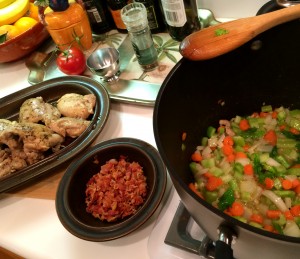 Add the onion, celery–the chopped celery and the tops, carrots, garlic and oregano to the pot. Cook the vegetables for 5-6 minutes, until the onions are translucent. Stir frequently.
Add the onion, celery–the chopped celery and the tops, carrots, garlic and oregano to the pot. Cook the vegetables for 5-6 minutes, until the onions are translucent. Stir frequently.
Put the heat on high. Add the cup of white wine. When it starts to bubble, let it cook off for 1 minute.
Reduce the heat to medium, and cook for 5 minutes, stirring often.
Add the chicken broth, and turn the heat to high.
Whisk in the flour, 1 tablespoon at a time, until it’s smooth and all the lumps are gone. When all 3 tablespoons have been whisked in, and it’s all smoovy-smoov…
Add the potatoes. When the broth comes to a boil, let the potatoes cook for 3 minutes, while boiling.
Reduce the heat to medium. Add the 2 tablespoons of sherry or sweet vermouth.
Cook for 15 minutes.
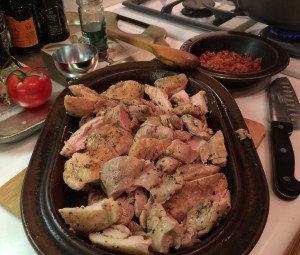 The chicken should be cool by now. Cut each chicken thigh into smaller pieces, about the size of a small egg.
The chicken should be cool by now. Cut each chicken thigh into smaller pieces, about the size of a small egg.
Put the chicken in the pot. Reduce the heat to medium-low. Cook for 20 minutes.
Don’t stir! This is a stew. Let it sit and stew for a while. You keep stirring this thing and potatoes are gonna break up, and chicken is gonna break down.
After 20 minutes, give it a stir. Then cook for another 20 minutes.
Add the peas and the cooked pancetta. Cook for 10 minutes.
Scrape the sides of the pot, right above the stew-line. Scrape it right into the stew, this is some flavorful stuff! Give the stew a gentle stir, taste for salt and pepper and adjust.
Stab a potato with a folk—it should be tender. Take a bite of the chicken—it should be firm and just a bit flaky—like me.
Dish it up, and…

